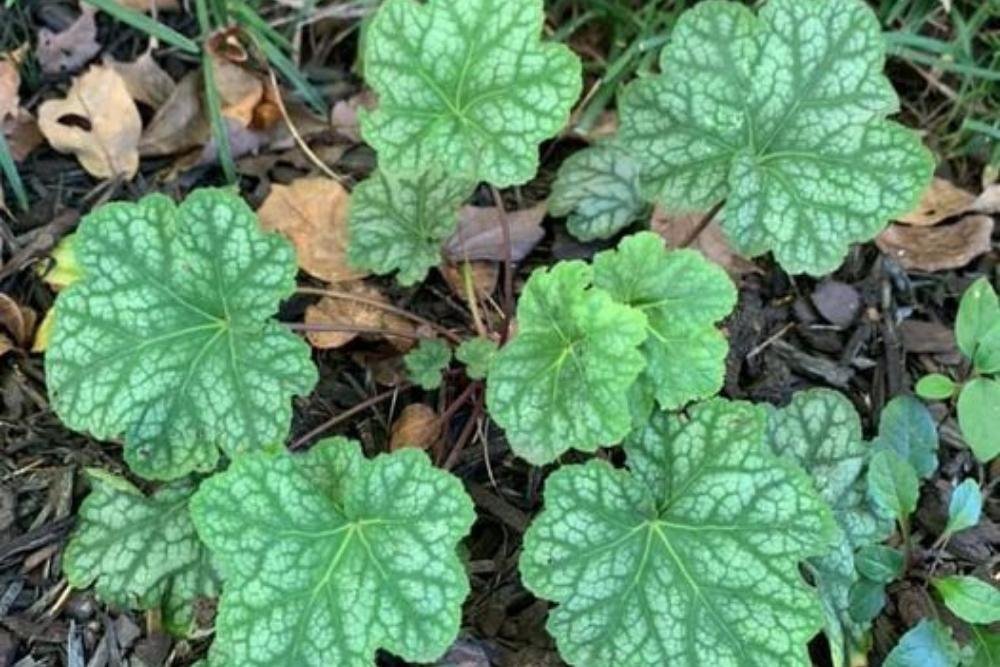Coral Bells, American Alumroot
American Alumroot (Heuchera americana) Photo: John Richards
Botanical Description: A gardener’s workhorse and a centuries old classic, the Alumroot/Coral Bells are a native genus of wonderfully attractive, clump-forming, herbaceous perennials in the highly diverse Saxifrage family - Saxifragaceae. Generally hardy from USDA zones 4 through 9, some species are adaptable in zones 3 through 11; alumroot/ coral bells are as reliable as they come in the plant world.
A moderately fast growing, mounding perennial, its attractive basal rosette usually grows about one foot tall and wide; once it produces its inflorescence (stalk of flowers), it can stand two to three feet tall. Foliage - a celebrated Heuchera trait - can be found in shades of bronze, purple, red and green. Typically deep, almost marbled variegated foliage defines its appearance.
In their southern ranges, coral bells are reliably evergreen. One species in particular, Maple-leaf alumroot (H. villosa), can be one of a southern gardener's most attractive evergreens - well utilized as a ground-cover when planted in mass. It is also broadly accepted as the most heat-tolerant of the Heuchera species.
While mostly a sun-tolerant species, plantings with more shade might be advantageous in southern plantings. In areas of full sun, consistent moisture and good drainage are key.
Coral bells perform best in moist, humus-rich soils, but can be somewhat tolerant of clay soil. For more compacted garden soils, amending with stone is important. Circumneutral to slightly acidic soils are ideal for Heuchera species, but they can tolerate slightly calcareous (basic) soils; ph ranges of 6-8 are acceptable.
The delicate flowers of coral bells are airy and inconspicuous unless observed up close. Depending on the species, coral bell blooms will first appear in the late spring or early fall. Its small flowers are bell-shaped in hues of white, pink, green or coral-colored, hence the common name “coral bells”. After flowering, its spent flowers cling to the upright stalk on which they are held, until autumn.
Heucheras are not known to be disease and insect prone, and can be a reliable native in a planting. Coral bells are susceptible to leaf scorch in areas where they receive too much sunlight. They can be susceptible to black vine weevils which may attack the lower stems of the plants or the root structure. If an infestation occurs, it can be treated with Neem oil to reduce the effects of the weevil.
Cultural Description: Known first by indengious peoples who shared settlements in areas where Heuchera grew, this plant served as an anti-inflammatory and as a useful medicinal panacea. Another of its uses and the reason for the name “alumroot” - is the astringent and tannin-rich roots that act as a pickling agent, similar to alum itself. Like many other plants, Heuchera was a readily available and widely used multipurpose plant.
Later, described by the first European colonists in the 16th century, Heuchera gained popularity back home. A well-known garden classic by the 18th century, many cultivars would eventually be displayed in gardens and greenhouses throughout Europe. Due to the coral-colored flowers of some species, a later-discovered species of alumroot (H. sanguine), would give rise to one of its common names - Coral Bells.
Formally described and named in the 18th century by none other than Carl Linnaeus, Heuchera was named in honor of the esteemed physician and medical botanist, Dr. Johann Heinrich von Heucher.
Natural Habitat: Our native Heuchera species frequently occupy areas in which the substrate is composed of various-sized rocks with shallow soils. They thrive on cliffs, ledges, and slopes that are partly shaded. Often, you will find them growing out of cracks in boulders in cool, shaded environments or open woodlands.
Habitat Value: Though small and delicate, the many small flowers of Heuchera species are an excellent source of nectar and pollen for native bees, butterflies, and even hummingbirds. Deer and rabbits don’t favor these species due to the tannin in their foliage. However, if hungry enough, they will sometimes ingest these plants.
Landscape Value: Coral bells of all stripes and colors are desirable and useful plants in landscapes. Due to its overwintering green foliage in the south, species of Heuchera are excellent options for an evergreen ground cover, especially when planted close together. They are also useful for border and edge plantings, walkways, rock gardens, and wooded areas. Once established, they require very little maintenance
Heuchera serves many purposes in the landscape, both aesthetically and as a benefit to nature. They are easy to grow, durable, and beautiful.
Description curated by Charlie Belin & Dylan L. Hackett


